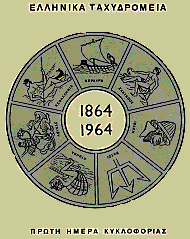|
While good genealogy most often means working backwards from the present, sometimes we must make our own clues. Reaching back through the History of Greece, the literature shows many Halkiopoulos or Halikiopoulos men who played notorious roles in the development of the the nation. Often their role was balanced between occupying powers and the locals. I have concentrated my study in areas where there are many Halkiopoulos families between the Ionian Islands and Crete. These especially include those islands as well as Santorini, Naphlion, Athans and Patras. Within the Ionian Islands I extend my study beyond Kefalonia to include Corfu, Lefkada and Ithaci. Below is a small selection of references, which are organized by location, that follow these men and that offer other clues to consider in my research. These references will grow as I continue to find and translate them:
KEFALONIA:
- Betty Kagia, Kefalonia and Ithaki, The Kingdom of Odysseus, (Grecocard Publications, 1994):
- Areference is made to a "Halikiopoulou locale" near Asprogerakas on Kefalonia, where the ruins of the church Agios Nikolaos, to which the nuns of Atros, being pursued by the Turks in 1598, took refuge. The church belonged to the monastery of Aggios Gerassimos. This is located between the village of Asprogerakis and the paved highway to Poros. page 62
- Prior to that beginning in the 16th century, The Venetians allowed immigrants from the Peloponnese to settle in Moussata, a village off the southern coast deserted by the locals because of pirate attacks (Kagia, 1994).
- A town in the southeastern portion of the island, near Poros, Atsoupades along the coast was settled by refugees fleeing the Turkish occupation in Crete during the late 17th and early 18th centuries. More specifically the dates range from 1647 to 1669 . That village name was taken from a similar name in Crete: Atsipada (Kagia, 1994). That village name was taken from a similar name in Crete: Atsipada (Kagia, 1994).
- (Molly Green, A Shared World, (Princeton University Press, NJ, 2000}:
- The governor of Kefalonia was Cretan as a reward by the Venetians for his efforts fighting the Turks n Crete.(Greene p.82)
- It is known that people who migrated to the island during the British occupation often falsified their names to make their origins sound more like one who originated from the Kefalonia. Greene p ?
- Ciotou, Panagiotou, History of the Ionian State From Self-rule Until the Union, 1815-1864, Vol B, (Bibliopoleio Dionysioy Boti Karabia, Athens), 1877 (in Greek):
- Manizaros Iaxobos Halikiopoulos, pp. 5, 12 (Item not yet translated.)
- Panayioytis Halikiopoulos, p. 573 (Item not yet translated.)
- Ciotou, Panagiotou, History of the Ionian State From Self-rule Until the Union, 1815-1864, Vol A, (Bibliopoleio Dionysioy Boti Karabia, Athens), 1874 (in Greek):
- Stanos Halikiopoulos, pp. 87, 114, 525 (Item not yet translated.)
- Stuliano Halikiopoulos p. 94 (Item not yet translated.)
CORFU (Kerkeria)
- Many of them lived in Corfu (Kerkyra), as do now many of their descendents. Forming the west shore of the Kanoni peninsula, there is even a lake near the airport called the Halikiopoulos (or Halkiopoulos depending on the source) Lagoon.
- Pratt, Michael, Britain's Greek Empire, (Rex Collings, London), 1978 (in English):
- Refers to the Khalikiopoulos family's trusted reappointments to the Regency of Corfu during the first thirty years of the British Protectorate, 1815-1864. Halkiopoulos, being a Peloponnesian name, might have stood out to immigration officials during the British Protectorate (1809-1863).
- There is a lagoon south of Corfu Town on the Island of Corfu named Halkiopoulos. I have found numerous Halkiopoulos vital records there through the LDS Family History Center, but found no records that match my family's. There are still some Halkiopoulos families on Corfu to this day. No document in my possession, though, refers to Corfu in connection with my particular family.
|


